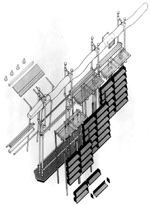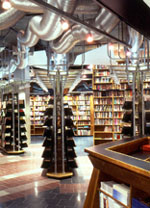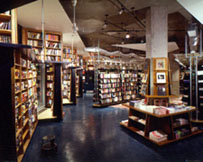- Categories:
St. Mark's Bookshop -- An Award-Winning Environment for Discriminating Readers
When Bob Contant and five partners opened the St. Mark's Bookshop in Manhattan's East Village in 1977, the neighborhood was home to counterculture businesses such as the Intergalactic Trading Post -- a drug-related head shop, the Electric Circus disco, and residents such as Abbie Hoffman. "It was a boom time for the East Village," Contant told BTW. "St. Mark's Place was the center of the hippie universe."
The neighborhood still serves up a large slice of counterculture but also includes an enormous academic constituency (New York University, New School University, and the Cooper Union are all in close proximity), many fairly conventional professionals, and some curiosity seekers. The store keeps hours fairly typical in the East Village -- until midnight seven days a week, opening at 10:00 a.m. every day but Sunday when it opens at 11:00 a.m.
Contant, co-owner Terence McCoy, and three others who have since left the bookstore, each put up $2,000 to open the 600-square-foot store, which was on the north side of the dynamic block. During its 10-year stint at that location, the owners increased the store's square footage by 400 feet, while their rent went from $375 per month to about $5,000. The store crossed St. Mark's Place in 1987 to occupy 1,900-square-feet in a landmark building, once home to a German shooting club.
From 1987 to 1993, St. Mark's Bookshop weathered a number of storms including the "dramatic deterioration" of St. Mark's Place on which clothing stores replaced a diverse selection of small businesses, and street peddlers lined the block with tables of goods, including many art books, at suspiciously low prices. Contant told BTW that he has long believed that these venders are trafficking in stolen goods and that, unlike the city's many food venders, they are not licensed or monitored in any way. Financially, the severely undercapitalized store was near Chapter 11 in 1989. "We had the signs up in the windows," Contant said. "We were about to close."
Help came in the form of organic food publisher Robert Rodale, who read an article in the Wall Street Journal about the store's dire financial situation from his home in Maine. According to Contant, within days, Rodale arrived at the store ready to offer substantial help. "We continue to exist because of the generous support of Robert Rodale. He wanted to support our kind of small business. He proposed a loan arrangement that we then had to sell to our hundreds of creditors. Once the majority of them accepted it, he gave us the help. We never sold Rodale Press books, that wasn't the connection -- but the store had a number of connections for him -- his father, the company's founder, had been involved with a Yiddish theater in the East Village; Robert was an Olympic skeet shooter, and we were housed in an old shooting club; and while traveling in China he had become friendly with one of our best customers -- Susan Sontag."
Rodale died soon after the loan was arranged, but his assistance enabled the store to survive and thrive and, in 1993, when Contant and McCoy were ready to move off of St. Mark's Place, Rodale's estate loaned them money for the renovation. Fearful of incurring tremendous debt from another move, the owners proceeded cautiously. Their wait was fortuitous when the Cooper Union (for the Advancement of Science and Art) reduced the rent on a 2,500-square-foot space on the ground floor of one of the college's dormitories. The move around the corner to Third Avenue between 8th and 9th streets satisfied the owners' desire to stay a part of the East Village neighborhood, while the store gained a higher profile on a busy avenue and a more comfortable atmosphere for many of its patrons.
|
An architectural drawing for St. Mark's Bookshop
|
 |
|
Photo credit: Zivkovic Associates Architects, NYC
|
According to Brian Connolly, a principal in the architectural firm, Zivkovic Associates, which designed the new store, "Their clientele had matured and grown with the neighborhood. They wanted to keep their existing clientele without alienating any old ones." The design, which won four awards in the field including the Society of American Registered Architects 1993 Award of Excellence, has been featured in at least 19 publications internationally. Connolly told BTW that the storeowners communicated clearly that they "did not want the store to look like Barnes & Noble." They wanted to "avoid the use of expensive moldings and hardwoods that typified the more traditional appearances of several 'superstores' opening throughout Manhattan at that time." (To read more about how the architectural firm designed the store to meet the owners' requirements, click here.)
 |
|
Photo credit: Zivkovic Associates Architects, NYC
|
No one would mistake St. Mark's Bookshop for a Barnes & Noble. Air conditioning ducts run across the ceiling, some floors are painted concrete, and industrial materials are used throughout. Scanning the shelves -- Danielle Steel and Judith Krantz are nowhere to be found. Nor are any other chain blockbusters. The Post-Structuralist Philosophy section is gone (It's passé, said Constant), but esoteric Critical Theory is second only to Literature as the bestselling category. The Poetry section, the third highest-selling category, comprises 3,500 titles -- many are chapbooks, some from small, independent presses, and others from miniscule presses. "We carry books without ISBNs," Contant told BTW. "We represent quite a bit of stuff-- we have to monitor our inventory ruthlessly and not be indiscriminate."
 |
|
Photo credit: Zivkovic Associates Architects, NYC
|
Contant and McCoy understand the iconoclastic nature of their clientele and know that they can't sell books that are "too popular." "Once a book is made into a movie -- that's the kiss of death for us. Forget about the philosophy of hand selling -- nobody here wants to be told what to read. There are no staff picks. We present new titles in all subject areas and people find out for themselves," Contant explained. "We've sold more copies of Noam Chomsky's book on 9-11 than any other store in the country." (Power and Terror: Post 9-11 Talks and Interviews, Seven Stories Press).
Book Sense titles do overlap with some of St. Mark's favorites because, "[Book Sense] has a lot of value in the publishing world. It's a way midlist books can be supported. We specialize in midlist books. Book Sense can also recommend things that are not commercial."
Business has slowed as New York's economy has experienced a downturn, people are buying fewer books, and the once active tourist trade has disappeared since September 11, 2001, Contant said. Slower sales are offset somewhat by what Contant describes as an increasing acceptance of the purchase of hardcover books. "Paperbacks are so expensive --too expensive --so people are more willing to spend a bit more on a hardcover. And people don't want to wait until the paperback comes out. New Yorkers are so impulsive -- they want it now." --Nomi Schwartz

